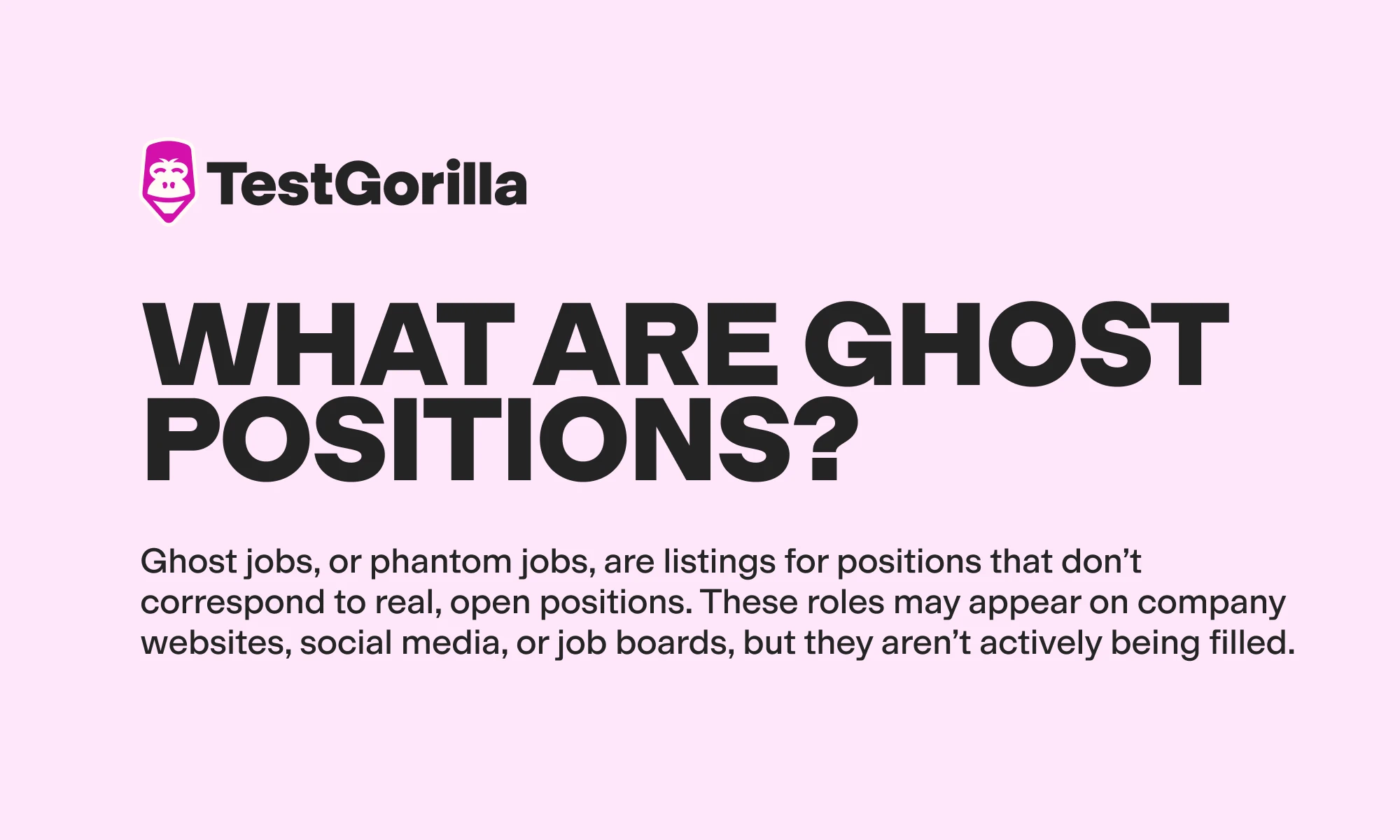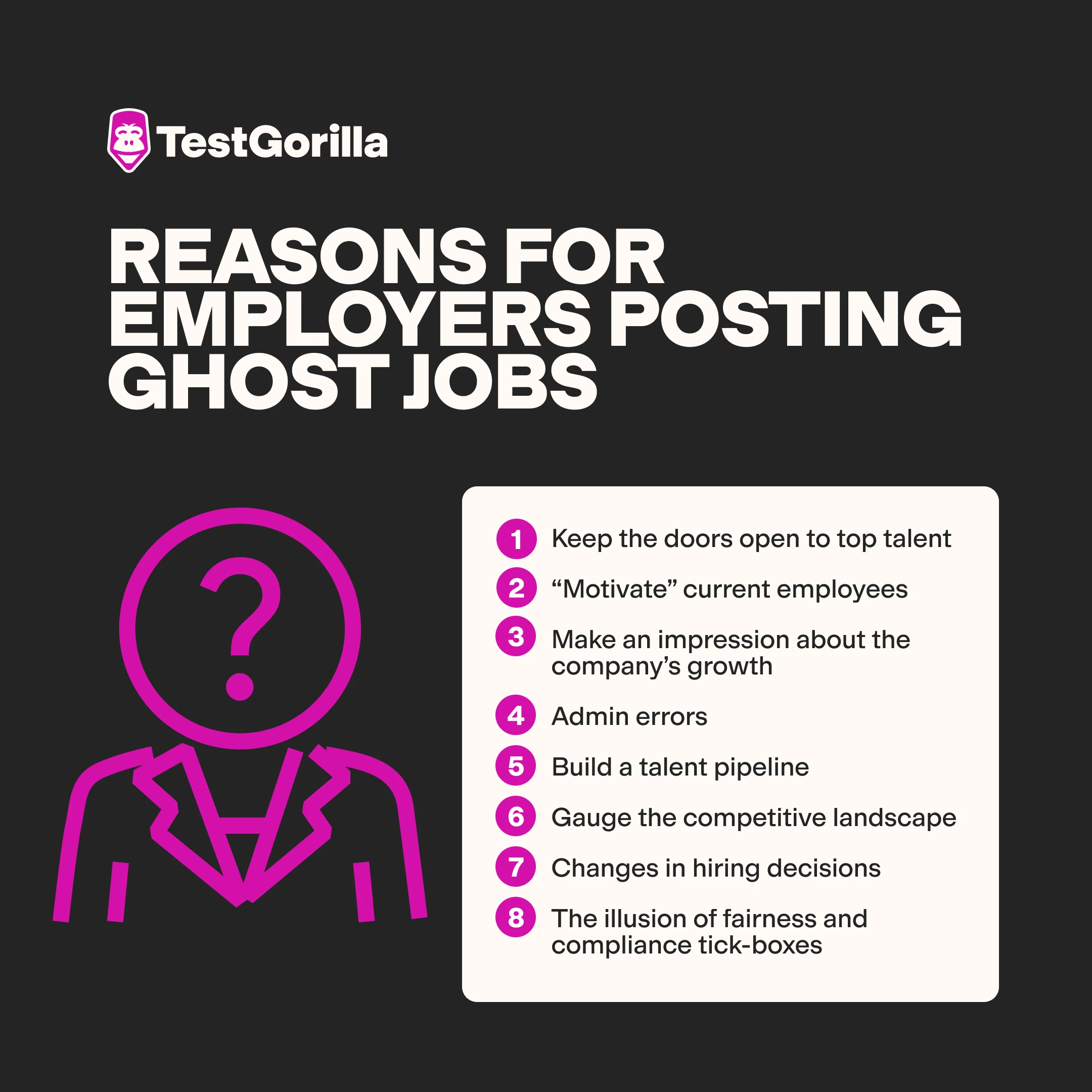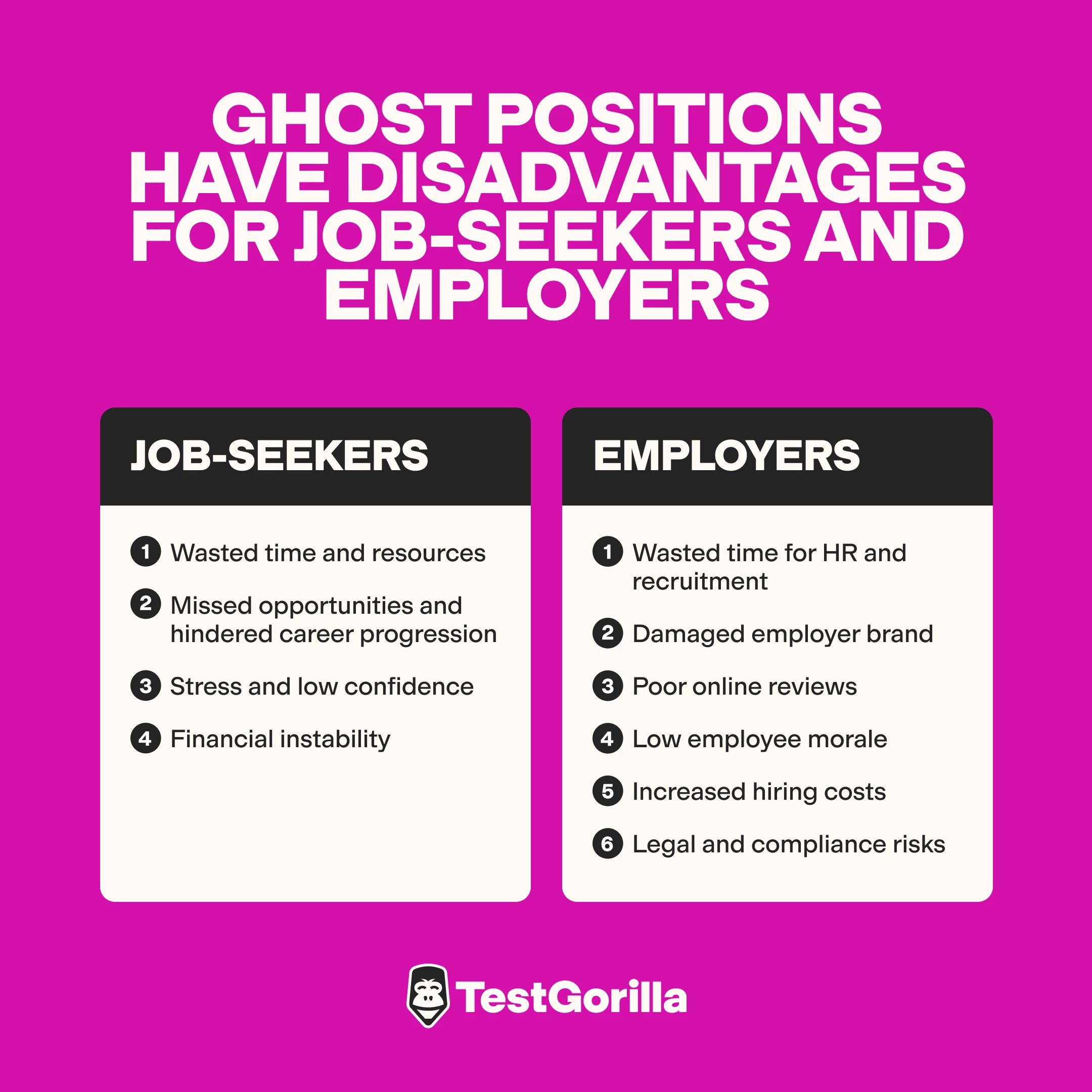Ghost jobs – job postings for roles that don’t exist – are on the rise. While many employers think they’re just gathering market intel or staying relevant, ghost jobs can seriously backfire. They not only shake candidates’ trust in fair hiring practices but can also damage your company’s reputation and employer brand.
We get it – the market is tough, and you want to stay competitive. But posting ghost jobs is risky business. In this article, we dive deep into ghost jobs and their dangers for employers and job seekers. We also offer tips on how to stand out and land top talent in more ethical, safe, and effective ways.
What are ghost positions?
Ghost jobs, or phantom jobs, are listings for positions that don’t correspond to real, open positions. These roles may appear on company websites, social media, or job boards, but they aren’t actively being filled.
Here are some examples:
New positions are posted with no hiring intention whatsoever.
Expired job listings remain online.
Jobs are posted publicly to give the illusion of fairness while the company already plans to promote or hire internally.
According to a recent survey of nearly 650 hiring managers, 40% of companies posted fake job listings between January and May 2024. Other studies estimate that as many as 80% of recruiters have admitted to posting fake jobs.
Ghost jobs are trending. The question is, why?
Why employers post ghost jobs
Clarify Capital, a financial consulting firm, surveyed over 1,000 hiring managers who were involved in posting ghost jobs. According to the responses, here are the most common reasons employers weren't filling their open roles:
1. Keep the doors open to top talent
50% of hiring managers said they posted ghost jobs because the “company is always open to new people.” Additionally, 35% said it was “in case an irresistible candidate applies.”
These results show that some employers post ghost positions out of “FOMO” – the fear of missing out on top candidates.
2. “Motivate” current employees
By posting ghost jobs, some employers are trying to build a sense of replaceability for their existing employees in the hope that it drives them to work hard. A whopping 43% of respondents said they did it to motivate internal employees.
3. Make an impression about the company’s growth
Another 43% of participants said they posted fake jobs to give the impression that the company is growing to impress employees, customers, or investors.
4. Admin errors
Errors in communication between recruiting and hiring managers can lead to companies forgetting to delist closed positions. 39% of hiring managers said they had a ghost job open because the “job was filled,” while 27% said it was because they forgot to delete the job.
5. Build a talent pipeline
37% of companies want a pool of qualified candidates ready to go in case of turnover. When posting ghost jobs, employers can easily collect resumes, personal information, skills assessment results, and more to build a pipeline of impressive people and keep them on standby for future needs.
Other reasons
We also spoke to HR and hiring expert Yashna Wahal, who shared other reasons employers post ghost jobs.
6. Gauge the competitive landscape
Some employers post ghost positions just to gather market intelligence and assess the competitive landscape without committing to hiring anyone – or even building a talent pool. By advertising a role, they can track the types of applicants they can attract, their skill levels, and even salary expectations.
7. Changes in hiring decisions
Sometimes, companies experience a shift in the budget, restructuring, or other unexpected events that lead to a change in hiring plans – for instance, a hiring freeze or canceling a role altogether. This can leave job-seekers guessing after they’ve applied for the position.
8. The illusion of fairness and compliance tick-boxes
Few employers post jobs to appear like they've given everyone a fair shot at the role despite having chosen someone internally.
Sometimes, they also do this to appear compliant with certain regulations. For example, UK skilled worker visa laws require companies to prove that no suitable local candidates are available for a role before they can sponsor a visa for international candidates. Some companies post these jobs publicly to appear as if they’re open to the market while they’ve already selected someone.
The best insights on HR and recruitment, delivered to your inbox.
Biweekly updates. No spam. Unsubscribe any time.
The dangers of ghost jobs for candidates and employers
Ghost positions have disadvantages for both job-seekers and employers. Let’s break them down.
Job-seekers
Here are four ways ghost jobs have a massive impact on candidates:
1. Wasted time and resources
One study found that candidates can spend up to ten hours writing resumes. Further, over eight in 10 employers look for candidates who tailor their resumes to the specific jobs they're applying for.
Imagine the time and resources job-seekers spend filling application forms, writing compelling cover letters, and creating job-specific resumes. Some applicants might even spend somewhere between $200 and $1,000 getting professionals to write their resumes. When they apply for ghost jobs, all this is for nothing.
2. Missed opportunities and hindered career progression
Ghost jobs can derail a job-seeker’s career progress by diverting time and energy away from genuine opportunities.
According to the Human Capital Institute, 75% of job applicants don't hear back from employers after submitting their applications. While some of this can be attributed to poor communication on the employer's part, ghost jobs certainly have a role to play. Candidates may miss out on real jobs because they’ve spent too long pursuing non-existent ones.
3. Stress and low confidence
According to a survey by scheduling platform Cronofy, the number of candidates who drop out of the application process when they don’t hear back from employers reduced by 7% between 2023 and 2024, signaling that candidates are less confident in the job market and more likely to hang around waiting for responses.
Applying for work is stressful enough, and ghost jobs add to the emotional toll by creating a false sense of hope and eventually leading to disappointment. Candidates feel strung along, waiting for responses and pinning their dream jobs on roles that will never materialize.
4. Financial instability
Job-seekers who are unemployed or between jobs rely on timely responses and speedy recruitment from companies so they can start work and keep up with the rising cost of living. Ghost jobs prolong the search process, leading to financial strain that can be particularly severe for candidates in urgent need of employment.
According to an Aerotek survey, most job-seekers (81%) feel stressed about their financial situation. Bryan Robinson, a contributing writer for Forbes, really hit the nail on the head when saying:
"There is no greater stress than uncertainty brought on by worries that come with dead-end job searches, shrinking financial resources, and a questionable job loss. The instability of questions like how will you find a decent-paying job, pay the mortgage, get the kids through college or retire can make you sick."
Employers
Ghost jobs don’t just impact candidates. You, too, can face some significant repercussions for posting fake jobs.
1. Wasted time for HR and recruitment
Screening job applications can take significant time for your recruiters and HR team. Here's how long hiring processes take:
First, it can take days of back and forth between recruiters and the business to create job descriptions.
Stratus HR, an HR outsourcing company, estimates that it takes 20 to 30 minutes to post just one job on job boards and careers websites.
The same article mentions that screening resumes can take between 30 and 90 seconds per resume.
For some ghost jobs, recruiters are expected to conduct initial screening interviews, which can take 15 to 30 minutes.
Ghost jobs lead to an influx of applications that HR or recruiting teams often need to review. This unnecessary administrative work wastes valuable time and energy that could have been spent on genuine hiring or HR needs.
2. Damaged employer brand
When candidates apply for jobs and never hear back, they often feel misled, frustrated, and lose trust in your company. This tarnishes your employer brand and reduces the likelihood that candidates will apply to your company for a role in the future.
In fact, research shows that 80% of candidates feel discouraged from applying for a role with companies that didn’t give them feedback on a previous application. And not just that, 50% of candidates said they wouldn’t purchase a company’s products or services if they had a poor candidate experience with the company.
By posting ghost jobs, you risk losing out not only on potentially high-quality candidates but also on business from frustrated applicants who are also customers.
3. Poor online reviews
The only thing worse than losing a high-quality applicant is losing many. When candidates have poor application experiences or figure out a position isn't real, they could post this information on platforms like Glassdoor and LinkedIn.
Jasmine Escalera, a career expert at MyPerfectResume, spoke about this in a recent Fortune article on ghost jobs, saying:
"The empowered job-seeker isn’t just empowering themselves through the use of technology to boost their brand. The empowered job seeker is also putting out information that is supporting other job seekers in a very powerful way."
A single candidate posting negatively about your company can have a domino effect. Statistics show that more than 50% of candidates don't apply to companies after reading negative reviews about them.
4. Low employee morale
Ghost jobs can affect your existing employees in several ways.
First off, posting fake jobs to “motivate” your team members to work harder can backfire. They could feel unappreciated for their contributions or become worried about losing their jobs, which can lead to stress and impact their performance.
Additionally, when employees see ghost jobs posted while their departments are under-resourced or facing cutbacks, it creates confusion and frustration.
Finally, if employees find out you're posting ghost jobs and tricking candidates, it could lead to internal distrust. According to Forbes, a lack of trust can shrink employees' commitment and loyalty toward your company.
5. Increased hiring costs
In the long run, damaging your employer brand can increase your recruitment costs. You might need to spend more in your recruitment efforts or offer candidates higher salaries to compensate for the distrust or negative reviews you've received online.
Furthermore, when you post ghost jobs, you’re likely still paying a subscription fee to applicant tracking systems or paid job boards. Some employers might even shell out additional cash to advertise ghost positions to encourage applications.
6. Legal and compliance risks
Ghost jobs can put you at legal risk regarding employment laws and fair hiring practices. According to a recent article, government bodies that already investigate false advertising, such as the Federal Trade Commission (FTC), could soon crack down on companies posting fake jobs in the US.
Similarly, the Labor Minister in Ontario, Canada, has proposed a rule that requires employers to disclose if their job listings are active or for future consideration. Violating these rules in the future can result in lawsuits or penalties, add unnecessary costs to your company, and damage your reputation.
How candidates and employers can avoid ghost jobs
Here’s how job-seekers can identify ghost jobs, how you can avoid posting them, and how you can prevent candidates from mistaking real jobs for ghost jobs.
Candidates | Employers |
🔍Check the job posting date Before applying, always check the date the job was posted. Look at job boards, social media platforms, and the company’s career page. Research says the average time to hire is about 44 days, so if a job listing has been open for two months or more or has different dates across different platforms, it could be a ghost job.
| ✅ Remove outdated listings Assign someone on your team to regularly review your company’s job postings and remove any jobs that you’re not hiring for or have already been filled. Ensure this is done across all job boards, social media platforms, and your company's career page. |
🔍Check the nature of the role Some jobs – for instance, an AI engineer – genuinely take longer to fill because they require highly specialized skill sets that aren’t readily available If you’ve applied for a role that isn’t niche – for instance, in digital marketing – and it’s been open for long, it’s likely a red flag. | ✅ Be transparent about job listings To avoid misleading candidates, clarify whether your open roles are for immediate hire or for future consideration. For example, Deloitte has a ”Future Opportunities” portal that lets candidates submit their resumes for review, even if there’s no open position that matches their skill set. This is a great way to build your talent pipeline transparently. |
🔍Beware of repeated postings Look for patterns where companies repeatedly put the same role description up over a short period, as this could be a ghost job.
| ✅ Avoid posting evergreen roles indefinitely Post roles only when you have approval to hire, and remove listings once they’re no longer active. If you’re genuinely hiring for the same type of role often – for example, software engineer – ensure you make thoughtful changes to the job listing so it doesn’t appear like a ghost job. This could be as simple as sharing information about which department you’re hiring the software engineer for. |
🔍Spot vague language in job descriptions Job descriptions with vague language could be indicative of ghost jobs. Look out for: Job titles that don't specify the department or level – for instance, “marketing expert.” Responsibilities that don’t mention what the day-to-day tasks are – e.g., “work on various projects” or “help with company growth.” Requirements that don’t discuss the specific skills and qualifications for the role – for example, “Looking for a go-getter with an entrepreneurial spirit.” | ✅ Provide skills-based job descriptions Ensure all your job descriptions are clear, specific, and skills-based – i.e., tell candidates exactly what hard and soft skills they need for open roles. Detailed information on responsibilities, qualifications, and hiring timelines makes candidates more likely to trust that the position is legitimate and reduces the likelihood of mistaking actual positions for ghost jobs. |
🔍Research the employer on platforms like Glassdoor and LinkedIn Look for previous candidates’ reviews on websites like Glassdoor and Linkedin and on the company’s social media pages to see if there are frequent complaints about ghost jobs. | ✅ Provide timely responses One report shares that 81% of candidates want continuous communication through the application process. Ensure you provide feedback to all candidates, including those you’re rejecting. When the candidate volume is too high, consider using automated messages – an option provided by any good applicant tracking system so you don’t need to do this manually. Finally, if you change your mind about an open position or notice that candidates have applied to a role mistakenly left open, communicate with candidates transparently so they’re not left in the dark. |
Four better ways to build your talent pipeline and gather data
Consider these alternative strategies that give you the benefits of ghost jobs – like gathering data and expanding your talent pool – without the risks:
1. Use skills assessments
When you ask candidates to submit their resumes to your company for future consideration, invite them to take quick talent assessments as well. You can mandate essential soft skills assessments, such as a communication test, that are relevant to most roles. Also, provide a list of hard skills tests so candidates can choose the most relevant ones to complete.
This is an excellent way to build a database of qualified candidates for future roles. It also shows you genuinely care about candidates’ skills, which is great for your brand.
2. Establish an employee referral program
Implement an employee referral program where your existing employees can recommend talent from within their networks for open positions and future consideration. This way, you can gather details for skilled candidates who could also be a good culture fit for your company.
3. Keep prior candidates warm
Ensure you stay in touch with impressive candidates who may not have made the cut for a previous role or didn't accept your offer. Keep them posted with newsletters or other comms, and contact them when a suitable role opens up.
4. Opt for surveys or external research to gather market intel
Lastly, consider sending your talent database surveys to collect information about their skills, salaries, and more. Offer incentives such as money or free products to encourage participation. Additionally, use industry benchmarking reports for deeper insights into hiring trends, pay expectations, etc.
Eliminate the dangers of ghost jobs with skills tests and more
Many employers have started intentionally posting fake job listings – popularly known as ghost jobs – to stay visible, build a candidate database, and gather market data. Others accidentally wind up advertising ghost jobs when they forget to delete an old job posting.
But ghost jobs are bad news. Not only do they waste candidates' time and diminish trust, but they also damage your reputation and put you at legal risk.
You can avoid these challenges by providing transparency about role timelines, regularly reviewing and deleting old postings, and writing detailed role descriptions for actual jobs. Further, talent assessments like TestGorilla’s, employee referral programs, and candidate surveys can help you collect better insights than any ghost job could.
You've scrolled this far
Why not try TestGorilla for free, and see what happens when you put skills first.





















